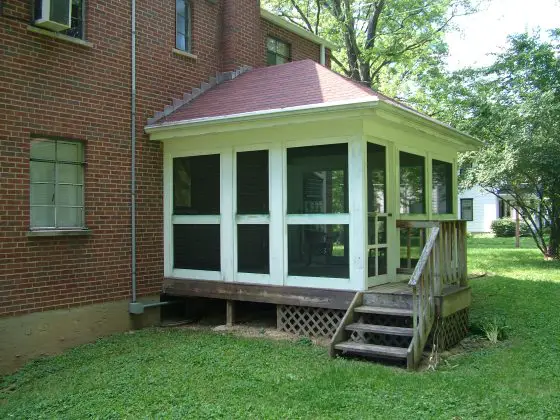Screened Porch Design

This screened-in porch needs a paint job, but its design is perfect. I know as the owner still compliments me 20 years after I built it. PHOTO CREDIT: Tim Carter
DEAR TIM: The next project at my home is a screened porch. I have looked at many screened-porch plans, but none of them really excite me. While looking at some pictures of screened-in porches, I have some really good ideas about what I want in my screened porch design. What should I take into consideration in this planning phase so that I end up with the perfect screened-in porch? Caroline M., Belmont, NH
DEAR CAROLINE: Screened-porch designs, and I mean good ones, are often hard to discover. My feeling about this stems from the fact that most of the ones I have seen seem to be mutations of decks that are just thrown onto the rear or side of a home. You have to keep many things in mind when you decide to build a screened porch.
The first thing you need to consider is the size of the screened porch. One really effective way to create the floor plan is to buy the furniture you intend to use on the porch before you build the structure. Set the furniture up in your yard spacing it exactly as you intend to place it on the finished screened porch. Be sure you have the spacing correct so people can walk freely around the chairs, tables and any decorative items you may have.
Use string to create the outline of the porch so you can see the shape and get fairly accurate measurements. My guess is that you will discover that you need a screened porch that measures at least 15 feet by 15 feet to seat at least eight or more people comfortably.
The outside design should match the style and character of your home. This means you should copy the roof pitch as well as the exterior trim details. The overhang of the screened-in porch needs to match your existing one or be in scale if your home is a two story.
Be very aware of interior hallways or pathways within the floor plan of the porch if you plan to have a door leading from the porch to your yard. A doorway will often consume 15 or 20 square feet of floor space inside the screened porch, especially if it is placed in a corner.
I urge you to give serious consideration to a vaulted ceiling inside the screened porch. This design detail is magical as it creates a feeling of immense spaciousness. A vaulted ceiling also helps keep the porch slightly cooler as hot air can easily rise up to the highest point of the roof and exit through ventilation devices installed with the roofing.
Your outdoor screened-in porch design should include soft indirect lighting that bounces off the ceiling as well as task lighting over a table. You want to be able to see what you are eating or what cards you were dealt as that poker game extends into the night.
Be sure to plan for adequate electric outlets in key locations where you might place a television, sound system or any other appliance than needs electricity. You must avoid extension cords at all costs, as they can be very dangerous.
You are going to get many pleasant benefits from your new screened porch, but be aware there are undesirable secondary effects that catch people off guard. These structures are almost always added to a home. The natural light entering the finished room that abuts the screened porch is always significantly diminished. That room will be dark and gloomy, so it may need additional artificial lighting to compensate. You can add skylights in the screened porch to help get additional light into the house.
Be sure the walls of the screened porch are tall enough so that views are not blocked by the roof overhang, any beams that are supporting the roof and the actual finished framing around the screens. You may discover that you need a wall height of at least 9 feet to ensure the views from the porch are only obscured by the screening itself.
The flooring of the screened porch is important. It needs to be weatherproof and good looking at the same time. Be aware that tiny bugs can come up through any cracks or gaps in the flooring unless you have screening that extends all the way to the ground around the structure. The roof will protect the flooring from much of the sunlight, but driving rain will get the floor wet on many occasions.
Be sure to include a powerful ceiling fan in your design. You may need the air movement on evenings or days that are hot and devoid of wind or breezes. A high-quality ceiling fan will be whisper quiet or completely silent so you can hear nothing but the pleasant sounds of nature just the other side of the screening.
Related Column:
Create a Utility Screened Porch
Column 729